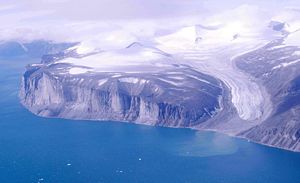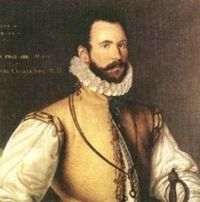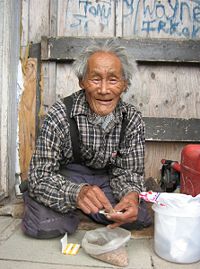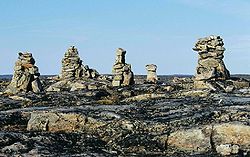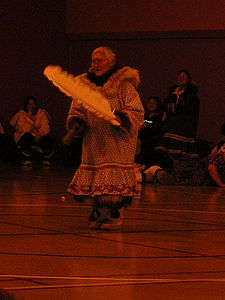Nunavut
| |||||
| Motto: Nunavut Sannginivut (Inuktitut: "Our land, our strength") | |||||
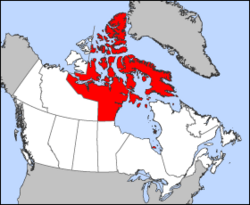
| |||||
| Capital | Iqaluit | ||||
|---|---|---|---|---|---|
| Largest city | Iqaluit | ||||
| Official languages | Inuktitut, Inuinnaqtun, English, French | ||||
| Government | |||||
| - Commissioner | Ann Meekitjuk Hanson | ||||
| - Premier | Paul Okalik (Consensus government) | ||||
| Federal representation | in Canadian Parliament | ||||
| - House seats | 1 (Nancy Karetak-Lindell) | ||||
| - Senate seats | 1 (Willie Adams) | ||||
| Confederation | April 1, 1999 (13th) | ||||
| Area [1] | Ranked 1st | ||||
| - Total | 2,093,190 km² (808,185 sq mi) | ||||
| - Land | 1,932,255 km² (746,048 sq mi) | ||||
| - Water (%) | 160,935 km² (62,137 sq mi) (7.7%) | ||||
| Population | Ranked 13th | ||||
| - Total (2008) | 31,142 (est.)[2] | ||||
| - Density | 0.015/km² (0/sq mi) | ||||
| GDP | Ranked 13th | ||||
| - Total (2006) | C$1.213 billion [3] | ||||
| - Per capita | C$39,383 (8th) | ||||
| Abbreviations | |||||
| - Postal | NU | ||||
| - ISO 3166-2 | CA-NU | ||||
| Time zone | UTC-5, UTC-6, UTC-7 | ||||
| Postal code prefix | X | ||||
| Flower | Purple Saxifrage | ||||
| Tree | N/A | ||||
| Bird | Rock Ptarmigan | ||||
| Web site | www.gov.nu.ca | ||||
| Rankings include all provinces and territories | |||||
Nunavut (IPA: /ˈnuːnəvʊt/) (Inuktitut syllabics: ![]() ) is the largest and newest territory of Canada; it was separated officially from the Northwest Territories on April 1, 1999 via the Nunavut Act and the Nunavut Land Claims Agreement Act, though the actual boundaries were established in 1993. The creation of Nunavut resulted in the first major change to Canada's map since the incorporation of the new province of Newfoundland in 1949.
) is the largest and newest territory of Canada; it was separated officially from the Northwest Territories on April 1, 1999 via the Nunavut Act and the Nunavut Land Claims Agreement Act, though the actual boundaries were established in 1993. The creation of Nunavut resulted in the first major change to Canada's map since the incorporation of the new province of Newfoundland in 1949.
The capital Iqaluit (formerly "Frobisher Bay") on Baffin Island, in the east, was chosen by the 1995 capital plebiscite. Other major communities include the regional centres of Rankin Inlet and Cambridge Bay. Nunavut also includes Ellesmere Island to the north, as well as the eastern and southern portions of Victoria Island in the west. Nunavut is both the least populated and the largest of the provinces and territories of Canada. It has a population of only 29,474 spread over an area the size of Western Europe. If Nunavut were a sovereign nation, it would be the least densely populated in the world: nearby Greenland, for example, has almost the same area and nearly twice the population. [4]
Nunavut means 'our land' in Inuktitut, the language of the Inuit. Its inhabitants are called Nunavummiut, singular Nunavummiuq.
Geography
The Canadian territory of Nunavut is a vast stretch of land which constitutes the greater part of the Canadian Arctic Archipelago, including its largest island, Baffin Island. It consists of approximately 750,000 square miles (1.9 million sq km) of land and 62,000 square miles (161,000 sq km) of water, including part of the mainland, most of the Arctic Islands, and all of the islands in Hudson Bay, James Bay, and Ungava Bay (including the Belcher Islands). Several islands in the area are divided between Nunavut and the Northwest Territories, notably Victoria and Melville Islands.
It is the fourth largest subnational entity (statoid) in the world. If Nunavut were a country, it would rank 13th in area, after the Democratic Republic of the Congo. Nunavut has land borders with the Northwest Territories on several islands as well as the mainland, and a tiny land border with Newfoundland and Labrador on Killiniq Island. It also shares aquatic borders with the provinces of Quebec, Ontario and Manitoba and with Greenland. The creation of Nunavut created Canada's only "four corners", at the intersection of the boundaries of Nunavut, the Northwest Territories, Manitoba, and Saskatchewan, at 60°00' north, 102°00' west, on the southern shore of Kasba Lake.
The mountains on the easternmost coasts of Nunavut are part of the Arctic Cordillera which stretches from northernmost Ellesmere Island to the northernmost tip of Labrador. The highest point is Barbeau Peak on Ellesmere Island at a height of 8,583 feet (2616 m), which is also the highest point in Nunavut. The Arctic Cordillera is the northernmost mountain range in Canada and offers some of the world's most spectacular scenery.
Nunavut comprises two distinct physiographic regions: the Canadian Shield, including the mainland and the islands around Hudson Bay, and the Arctic Archipelago in the north. The lowlands of the Canadian shield consist of very thin soil lying atop ancient bedrock, and many bare outcrops. This arrangement was caused by severe glaciation during the last ice age, which covered the Shield and scraped the rock clean. The extreme age of the base rock (Precambrian Era, over 540 million years old) is one the main factors for the rich veins of ores and minerals that have been found in the territory. The multitude of rivers and lakes in the entire region is caused by the watersheds of the area being relatively young and in a state of sorting themselves out with the added effect of post-glacial rebound. Virtually all of Nunavut's rivers drain into either the Hudson Bay or the Arctic Ocean.
Arctic tundra covers virtually all of Nunavut, the only exceptions being a tiny area in the extreme southwest near the "four corners" area, where a marginal taiga forest exists, and small zones of permanent ice caps, found on some of the larger Arctic Islands (especially Baffin, Devon and Ellesmere) at sites having a relatively high elevation.
Nunavut experiences bitterly cold winters and cool to cold summers. Though temperatures are harsh, with little precipitation and few trees, it is home to a number of species of plants and animals. There are herds of caribou (reindeer) and and musk oxen that feed on the lichens and plants. [5] Small, hardy shrubs, notably dwarf birches grow throughout the territory, in addition to a variety of flowering plants. Grizzly bears, wolves,Arctic foxes and red foxes are included in Nunavut's animal population, which also includes polar bears, walrus, and seals in its coastal areas. Beluga and bowhead whales and narwhals are found in coastal waters. Abundant insects in summer provide food for thousands of migratory aquatic birds. Only the snowy owl and gyrfalcon and species of ptarmigan live in the territory year-round. [6]
History
The region now known as Nunavut has supported a continuous population for approximately 4,000 years. Most historians also identify the coast of Baffin Island with the Helluland described in Norse sagas, so it is possible that the inhabitants of the region had occasional contact with Norse sailors.
The written history of Nunavut begins in 1576. Martin Frobisher, while leading an expedition to find the Northwest Passage, thought he had discovered gold ore around the body of water now known as Frobisher Bay on the coast of Baffin Island. [7] The ore proved to be worthless, but Frobisher made the first recorded European contact with the Inuit. The contact was hostile, with both sides taking prisoners who subsequently perished.
Other explorers in search of the elusive Northwest Passage followed in the 17th century, including Henry Hudson, William Baffin and Robert Bylot.
In June 1870 the Hudson's Bay Company transferred their holdings to the government of Canada. This immense region comprised all of non-confederation Canada except British Columbia, the coast of the Great Lakes, the Saint Lawrence River valley and the southern third of Quebec, the Maritimes, Newfoundland, and the Labrador coast. It also excluded the Arctic Islands except the southern half of Baffin Island; these remained under direct British rule until 1880. The present territory of Nunavut was a part of this vast land, known as the Northwest Territories.
In 1976 as part of the land claims negotiations between the Inuit Tapiriit Kanatami (then called the Inuit Tapirisat of Canada) and the federal government of Canada, the division of the Northwest Territories was discussed. On April 14, 1982, a plebiscite on division was held throughout the Northwest Territories with a majority of the residents voting in favor of division. The federal government gave a conditional agreement seven months later. The land claims agreement was decided in September 1992 and ratified by nearly 85 percent of the voters in Nunavut. On July 9, 1993, the Nunavut Land Claims Agreement Act and the Nunavut Act were passed by the Canadian Parliament, with the transition completed on April 1, 1999. [8]
Government
Nunavut's head of state is a Commissioner appointed by the federal Minister of Indian Affairs and Northern Development. As in the other territories, the commissioner's role is symbolic and is analogous to that of a Lieutenant Governor. While the Commissioner is not formally a representative of Canada's head of state, a role roughly analogous to representing The Crown has accrued to the position.
The members of the unicameral Legislative Assembly of Nunavut are elected individually; there are no parties and the legislature is consensus-based. [9] The head of government, the premier of Nunavut, is elected by and from the members of the legislative assembly.
Faced by criticism of his policies, Premier Paul Okalik set up an advisory council of eleven elders, whose function it is to help incorporate "Inuit Qaujimajatuqangit" (Inuit culture and traditional knowledge, often referred to in English as "IQ") into the territory's political and governmental decisions.
Owing to Nunavut's vast size, the stated goal of the territorial government has been to decentralize governance beyond the region's capital. Three regions—Kitikmeot, Kivalliq and Qikiqtaaluk/Baffin—are the basis for more localized administration, although they lack autonomous governments of their own.
The territory has an annual budget of C$700 million, provided almost entirely by the federal government. Former Prime Minister Paul Martin designated support for Northern Canada as one of his priorities for 2004, with an extra $500 million to be divided among the three territories.
In 2005, the government of Nunavut collaborated with the federal government and the technology firm SSI Micro to launch Qiniq, a unique network which uses satellite delivery to provide broadband Internet access to 25 communities in Nunavut. As a result, the territory was named one of the world's "Smart 21 Communities" in 2005 by the Intelligent Community Forum, a worldwide organization which honors innovation in broadband technologies.
Economy
Unemployment in Nunavut is higher than in the rest of Canada. The majority of those employed work in the service sector, particularly such government services as administration, health care, education, and welfare. Much of the territory's revenue comes from the federal government, though it is supplanted by local taxes.
Traditional activities of hunting and fishing remain. Some fish species (shrimp, turbot, and Arctic char) are fished and exported to southern markets. Much of the food in Nunavut is imported, supplanted by what the Inuit fish, trap (small animals) and hunt (sea mammals).
Nunavut's unique culture and natural beauty attract tourists, and the service industry surrounding this, though small is significant.
Mining is the principal resource-based industry in the territory. Its major operations are:
- Lupin Mine - 1982-2005 - gold (located near the Northwest Territories boundary near Contwoyto Lake) [10]
- Polaris Mine - 1982-2002 - lead and zinc (located on Little Cornwallis Island, not far from Resolute)
- Nanisivik Mine at Nanisivik - 1976-2002 - lead and zinc (near Arctic Bay)
- Rankin Inlet Mine - 1957-1962 - nickel and copper
- Jericho Diamond Mine - 2006-present - diamond (located 400 km, 250 mi, northeast of Yellowknife)
Demographics
One of the most sparsely populated habitable regions on Earth (density 0.015/km² [0/sq mi]), Nunavut consists of small settlements which are clustered largely in the coastal areas. [6] While there is some internal migration from the rest of Canada to Nunavut (usually on a temporary basis), there is very little external migration from outside the country to Nunavut.
Canada's 2006 Census recorded the population of Nunavut at 29,474, [1] with 24,640 people identifying themselves as Inuit (83.6 percent of the total population). Much of the rest (14.96 percent) are of European descent. The remainder (1.44 percent) consist of First Nations and Métis (mixed race) people. [11] Nunavut's small and sparse population makes it unlikely the territory will be granted provincial status in the foreseeable future, although this may change if the Yukon, which is only marginally more populous, becomes a province.
The three dominant religions in Nunavut are Catholicism, Anglicanism and Born again Christianity. Traditionally, Shamanism has always been a taboo subject in Inuit culture, not openly talked about. Shamans did not make their identity know, though the families and clans knew who to turn to when needed.
Language
Inuktitut (literally "like the Inuit") is the name of the varieties of Inuit language spoken in Canada. It is spoken in all areas north of the tree line, including parts of the provinces of Newfoundland and Labrador, Quebec, to some extent in northeastern Manitoba as well as the territories of Nunavut, the Northwest Territories, and traditionally on the Arctic Ocean coast of Yukon. It is recognized as an official language in Nunavut and the Northwest Territories.
Nunavut encompasses the geographically largest part of the Inuit world (not counting the uninhabitable Greenland ice shield), and includes large mainland areas and numerous islands divided by rivers, straits, Hudson Bay, and areas of ocean that freeze only for a part of the year. Consequently, it is unsurprising that it has a great deal of internal dialect diversity.
Nunavut's basic law lists four official languages: English, French, Inuktitut and Inuinnaqtun, but to what degree Inuktitut and Inuinnaqtun can be thought of as separate languages is ambiguous in state policy. The word Inuktitut is often used to describe both.
While the use of Inuktitut is promoted in the schools, there is some fear that without a proactive stance, the language may be lost, replaced by English. In his 2000 commissioned report Aajiiqatigiingniq Language of Instruction Research Paper to the Nunavut Department of Education, Ian Martin of York University states that a "long-term threat to Inuit language from English is found everywhere, and current school language policies and practices on language are contributing to that threat" if Nunavut schools follow the Northwest Territories model. He outlined a 20 year multi-model language plan to create a "fully functional bilingual society, in Inuktitut and English" by 2020. [12]
Of the 2006 population of 29,474, responses to the question of 'mother tongue' totaled 29,025. Of these, the most commonly reported languages were[13]:
| 1. | Inuktitut | 20,185 | 69.54% |
| 2. | English | 7,765 | 26.75% |
| 3. | French | 370 | 1.27% |
| 4. | Inuinnaqtun | 295 | 1.02% |
Culture
Inuit folk music has long been based primarily off percussion, used in dance music, as well as vocals, including the famous Inuit throat singing tradition. Immigration brought new styles and instruments to Nunavut, including country music, bluegrass, square dancing, the button accordion and the fiddle.
"Inuit Qaujimajatuqangit" is an Inuktitut phrase that is often translated as Inuit traditional knowledge, Inuit traditional institutions or even Inuit traditional technology. It comes from the verb root "qaujima-" meaning to know and could be literally translated as "that which has long been known by Inuit". It has recently become something of a political slogan in Nunavut, as the government attempts to integrate the traditional culture of the Inuit more into their modern governance structure in order to combat disempowerment. Its critics, however, tend to view it as little more than window dressing for more conventional politics.
Inuit Qaujimajatuqangit is a body of knowledge and unique cultural insights of Inuit into the workings of nature, humans and animals. Inuit Qaujimajatuqangit, then, has both practical and epistemological aspects that branch out from a fundamental principle that human beings are learning, rational beings with an infinite potential for problem-solving within the dictates of nature and technology.
Inuit Qaujimajatuqangit|176419932
Despite the impact of North American media and other modern influences, many traditional elements of the Inuit culture have been preserved. In the years following World War II, Canadian artist and author James Archibald Houston, with the assistance of the Hudson's Bay Company, was instrumental in the promotion and sale of Inuit art. Public policy has continued to encourage the development of Inuit traditions in arts and crafts—including stone carvings, weavings, and prints—providing an important supplementary source of income in some Inuit communities and making Inuit culture familiar to collectors worldwide. In the late 20th and early 21st centuries, the musical career of Inuit singer and lyricist Susan Aglukark also promoted greater understanding and appreciation of Inuit cultural life in a modern context.
Winter sports, such as hockey and curling, are popular in Nunavut, as are dogsled and snowmobile racing and traditional Arctic games. Outdoor activities, including hunting, fishing, hiking, and kayaking, attract visitors to the territory. Large areas of the territory are set aside as protected areas, including Quttinirpaaq National Park on Ellesmere Island; Auyuittuq National Park on Baffin Island; Sirmilik National Park on northern Baffin Island and Bylot Island; Ukkusiksalik National Park on the mainland; Queen Maud Gulf Migratory Bird Sanctuary, also on the mainland; and Thelon Wildlife Sanctuary, shared with the Northwest Territories.
By the mid-20th century most Inuit of the region, then a part of the Northwest Territories, had replaced their seminomadic hunting, fishing, and trapping lifestyle with a more sedentary style of living in settled communities, where dependence on government welfare support became the norm. Nutrition and health care improved, but there also were serious social problems related to alcohol and other substance abuse, unemployment, and crime. Dissatisfaction with those conditions and the wish to participate more directly in the processes of resource development led the Inuit to exert pressure on the federal and territorial governments to grant them greater control over the administration of their own affairs. In the mid-1970s the Inuit began negotiations to settle land claims and proposed the creation of a separate Inuit territory. A plebiscite in the Northwest Territories in 1992 approved the division of the territories. With that mandate, the Inuit and representatives of the federal government reached an agreement that produced two acts of the Canadian Parliament in 1993. The first, the Nunavut Land Claims Agreement Act, settled Inuit land claims against the government by giving the Inuit outright control of more than 135,000 square miles (350,000 square km) of territory and providing cash payments from the federal government over a 14-year period; the second, the Nunavut Act, established the territory of Nunavut out of the eastern portion of the Northwest Territories. Following a transitional period, Nunavut came into being on April 1, 1999.
After its inception, the Nunavut experiment in ethnic-based territorial government had mixed success. The economy grew, but it remained almost entirely dependent on transfers of income from the federal government. Despite a reawakening of native culture and pride, alienation of the territory's youth, unemployment, substance abuse, and other social ills common to the peripheral communities of North America persisted. Native elders, the territorial authorities, and the federal government continued to deal with these challenges in the early years of the 21st century.
Notes
- ↑ 1.0 1.1 Statistics Canada. 2006. Community Highlights for Nunavut Retrieved June 17, 2008.
- ↑ Statistics Canada. Canada's population estimates Retrieved June 17, 2008.
- ↑ Statistics Canada. Gross domestic product, expenditure-based, by province and territory Retrieved June 17, 2008.
- ↑ CIA World Factbook
- ↑ Whitney, S. 2002. Tundra. Blue Planet Biomes. Retrieved June 23, 2008.
- ↑ 6.0 6.1 Encyclopædia Britannica Online. 2008. Nunavut Retrieved June 23, 2008.
- ↑ Jay Makarenko. January 8, 2002. Nunavut - The Story of Canada's Inuit People Maple Leaf Web. Retrieved June 17, 2008.
- ↑ Canadian Broadcasting Corporation. Creation of Nunavut CBC Digital Archives. Retrieved June 17, 2008.
- ↑ Canadian Broadcasting Corporation. On the Nunavut Campaign Trail CBC Digital Archives. Retrieved June 17, 2008.
- ↑ Zinifex Limited. Zinifex Limited Retrieved June 17, 2008.
- ↑ Statistics Canada. 2006 Census Aboriginal Population Profiles Retrieved June 17, 2008.
- ↑ Canada Department of Education. Summary of Aajiiqatigiingniq Retrieved June 17, 2008.
- ↑ Statistics Canada. Detailed Mother Tongue (186), Knowledge of Official Languages (5), Age Groups (17A) (3) (2006 Census) Retrieved June 17, 2008.
ReferencesISBN links support NWE through referral fees
- Alia, Valerie. Names and Nunavut Culture and Identity in Arctic Canada. New York: Berghahn Books, 2007. ISBN 1845451651
- Canada Department of Justice. Statute Repository Retrieved June 17, 2008.
- Henderson, Ailsa Nunavut: Rethinking Political Culture. Vancouver: University of British Columbia Press, 2007. ISBN 0774814233
- Kulchyski, Peter Keith. Like the Sound of a Drum: Aboriginal Cultural Politics in Denendeh and Nunavut. Winnipeg: University of Manitoba Press, 2005. ISBN 0887551785
- Martin, Ian. December 2000. AAJIIQATIGIINGNIQ - Language of Instruction Research Paper Nunavut Department of Education.
- Sanna, Ellyn, and William Hunter. Canada's Modern-Day Aboriginal Peoples Nunavut & Evolving Relationships. Markham, Ont: Scholastic Canada, 2008. ISBN 9780779173228
External links
All links Retrieved May 11, 2008.
- Map of Nunavut
- Nunavut Act
- Legislative Assembly of Nunavut
- Nunavut Tunngavik Inc. - Nunavut Land Claims
- Explore Nunavut
- Nunavut Parks
- Nunavut Tourism
- CBC North Radio Newspage
- Territorial newspaper reporting in Inuktitut and English
| ||||||||||
Credits
New World Encyclopedia writers and editors rewrote and completed the Wikipedia article in accordance with New World Encyclopedia standards. This article abides by terms of the Creative Commons CC-by-sa 3.0 License (CC-by-sa), which may be used and disseminated with proper attribution. Credit is due under the terms of this license that can reference both the New World Encyclopedia contributors and the selfless volunteer contributors of the Wikimedia Foundation. To cite this article click here for a list of acceptable citing formats.The history of earlier contributions by wikipedians is accessible to researchers here:
The history of this article since it was imported to New World Encyclopedia:
Note: Some restrictions may apply to use of individual images which are separately licensed.

